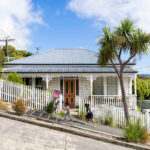Princes Street in Edinburgh is more than just a shopping thoroughfare; it’s a vibrant historical artery pulsating through the heart of Scotland’s capital. From its stunning gardens nestled in a former loch to the grand architecture housing department stores and monuments, Princes Street offers a captivating journey through Edinburgh’s rich past and present.
The Transformation of Nor Loch into Princes Street Gardens
The story of Princes Street begins with the Nor Loch, a body of water that once defended Edinburgh’s Old Town. However, by the 18th century, this loch had become heavily polluted, serving as a drain for the city’s sewage for centuries. In 1759, a significant transformation began: the draining of the Nor Loch. This ambitious project involved creating a canal that emptied into Lochend, near Calton Hill. By draining the loch, the city not only addressed a sanitation problem but also created space for what would become Princes Street Gardens.
West Princes Street Gardens in Edinburgh, showcasing lush greenery and walking paths, transformed from the historic Nor Loch.
The gardens were meticulously laid out, offering a picturesque green space in the city center. In the 1840s, another major development reshaped the landscape: the construction of the railway through the valley. Waverley Station, a major railway hub, opened in its current form in 1854. Initially named Canal Street Station, reflecting the area’s recent past, it was later renamed Waverley Station. The remnants of this earlier phase can be glimpsed in the name of Waverley Market, standing where Canal Street Station once was.
East Princes Street Gardens, Edinburgh, illustrating the Victorian landscaping and floral displays, a tranquil contrast to the bustling city.
Historical painting by Alexander Naysmith depicting the Nor Loch and Edinburgh Castle, providing a visual context of the area before its transformation into Princes Street Gardens.
Archival image of Canal Street Station in Edinburgh, the precursor to Waverley Station, highlighting the early railway infrastructure in the city.
Register House: Archival Treasures at the Foot of Princes Street
At the eastern end of Princes Street, where it meets North Bridge, stands Register House, a significant architectural and historical landmark. Built on what was then known as Multrees Hill, Register House opened its doors in the 1790s, with the New Register House, located on the west side on West Register Street, completed in 1858. These buildings were specifically designed to safeguard Scotland’s vital records, including births, deaths, and marriages. Today, Register House also houses the Scottish Tartans Authority, the official registry for tartan patterns.
Register House on Princes Street, Edinburgh, showcasing its neoclassical architecture and historical importance as a repository of national records.
New Register House on West Register Street, Edinburgh, an extension to the original Register House, expanding the archival capacity.
Historic view of Register House and the Crown Hotel on Princes Street, Edinburgh, illustrating the architectural landscape of the area in the past.
The Duke of Wellington Statue: A Tribute to Waterloo
Standing proudly outside Register House is the imposing statue of the Duke of Wellington. Erected in 1852, this monument commemorates the Duke’s victory at the Battle of Waterloo in 1815. Waterloo Place, the road leading towards Calton Hill, is also named in honor of this pivotal battle. The statue depicts the Duke astride his horse, Copenhagen, immortalizing both the commander and his valiant steed.
The Wellington Monument on Princes Street, Edinburgh, featuring the statue of the Duke of Wellington and his horse Copenhagen, a landmark commemorating the Battle of Waterloo.
Ritchie Clock: Timekeeping Innovation on Princes Street
To the west of the Wellington Statue, you’ll find the Ritchie Clock, a testament to Edinburgh’s early adoption of public timekeeping. This clock was part of the “Edinburgh Circle,” a network of electric clocks placed around the city by Frederick James Ritchie. These clocks were designed to provide accurate time to the residents of Edinburgh, showcasing an early form of public service and technological innovation.
The Frederick James Ritchie Clock on Princes Street, Edinburgh, an example of early public timekeeping devices and part of the historic Edinburgh Circle clock network.
Jenners Department Store: A Pioneer of Retail
Jenners Department Store, historically located on Princes Street, holds a special place as one of the world’s first department stores. Its origins trace back to 1838 when Charles Jenner and Charles Kennington, two drapers, established a store at 47 Princes Street. Jenners quickly gained renown for its high-quality goods and expanded over time, acquiring additional premises on Princes Street and South St David Street. By its peak, it was the largest department store in the United Kingdom.
Jenners Department Store on Princes Street, Edinburgh, showcasing its grand facade and historical significance as one of the world’s first department stores.
After Kennington’s retirement in the early 1860s, Charles Jenner became the sole owner. Tragedy struck when the store was destroyed by fire, but it was rebuilt in 1893 by the same architect who designed the iconic Balmoral Hotel. Jenners reopened in 1895 and thrived as an independent department store until its acquisition by the House of Fraser group in 2005. The store’s prestigious reputation was further solidified by the Royal Warrant awarded in 1911, reflecting its popularity among the British Royal Family.
The Forsyth Armillary Sphere: Steel Frame Innovation
Another architectural highlight of Princes Street is the corner building featuring the Forsyth Armillary Sphere. Dating back to 1906, this structure holds the distinction of being the first steel-framed building in Scotland. The Forsyth store is adorned with an armillary sphere, an astronomical instrument, featuring the signs of the zodiac and held in place by three gilded cherubs. This building stands as a testament to early 20th-century architectural innovation and design.
The Forsyth Armillary Sphere on Princes Street, Edinburgh, a decorative astronomical instrument adorning the corner building, symbolizing knowledge and history.
Sign indicating the Forsyth Building as the First Steel Constructed Building in Scotland, highlighting its architectural innovation and historical significance.
The Balmoral Hotel: A Landmark of Luxury and Location
Dominating the east end of Princes Street is The Balmoral Hotel, originally known as the North British Station Hotel. Opened in 1902, its prime location next to Waverley Station provides direct access to Edinburgh’s Old Town, including the Royal Mile, Edinburgh Castle, and the Palace of Holyroodhouse. Calton Hill rises directly behind the hotel, adding to its dramatic backdrop. The Balmoral stands on the site of Edinburgh’s first-ever hotel, The Crown, which later became the Royal Eagle and Prince Regent before being demolished to make way for the modern hotel.
The Balmoral Hotel on Princes Street, Edinburgh, an iconic luxury hotel showcasing its impressive architecture and prime location in the city center.
The Balmoral is famous for its clock, which is traditionally set five minutes fast. This quirky tradition was implemented to help railway travelers believe they were running late for their trains, adding a touch of unique Edinburgh character to the hotel’s history.
Royal Scottish Academy of Art: Nurturing Scottish Art
Located near Princes Street is the Royal Scottish Academy of Art, Scotland’s oldest and most prestigious academy dedicated to contemporary art. The Academy plays a vital role in supporting emerging artists from Scotland’s art colleges and promoting the work of living Scottish artists. Its entrance on The Mound offers easy access from Princes Street, inviting visitors to explore Scotland’s artistic heritage.
The Royal Scottish Academy of Art entrance from Princes Street, Edinburgh, highlighting its role in promoting Scottish art and its accessible location.
Waverley Station and Waverley Mall: A Transportation Hub and Shopping Destination
Waverley Station, a major transportation hub, has several entrances, including one directly on Princes Street. Built in 1854, Waverley is Edinburgh’s primary railway station, offering connections throughout Scotland and direct lines to major cities like London. The station also provides access to Waverley Mall, a shopping center built above the station, creating a multi-layered urban space.
Waverley Station Entrance on Calton Road, Edinburgh, showing one of the access points to this major transport hub.
Princes Street Entrance to Edinburgh Waverley Rail Station, indicating the station’s accessibility from this central thoroughfare.
Waverley Station Entrance on Market Street, Edinburgh, another access point illustrating the station’s extensive network of entrances.
St. John’s Church Graveyard: Resting Place of Notable Figures
Nestled at the west end of Princes Street, St. John’s Church and its graveyard offer a tranquil contrast to the bustling street. The graveyard is the final resting place of several notable figures, including Dean Ramsay, a clergyman who served at St John’s for 45 years. A Celtic Cross memorial stands in his honor near the Princes Street Gardens entrance.
Dean Ramsay Memorial Cross in St. John’s Church graveyard, Princes Street, Edinburgh, commemorating the long-serving clergyman.
St. John’s Church at the west end of Princes Street, Edinburgh, providing a peaceful setting and historic graveyard.
Anne Rutherford, mother of the renowned author Sir Walter Scott, is also buried here. Born in 1733 and passing away in 1819, her grave is located on the east side of St John’s Church. Her lineage connected to the Swinton family, one of Scotland’s oldest, and her son’s literary legacy make her a significant figure in Scottish history.
Anne Rutherford’s headstone in St. John’s Church graveyard, Princes Street, Edinburgh, marking the resting place of Sir Walter Scott’s mother.
Anne Rutherford’s grave in St. John’s Church graveyard, Princes Street, Edinburgh, a site of historical and literary interest.
Sir Henry Raeburn, a celebrated Scottish portrait painter, also has a memorial stone in St. John’s Church, close to Anne Rutherford’s grave. Born in Edinburgh in 1756, Raeburn became a leading figure in Scottish art, knighted in 1822 and serving as portrait painter to King George IV.
Sir Henry Raeburn’s headstone in St. John’s Church graveyard, Princes Street, Edinburgh, commemorating Scotland’s foremost portrait painter.
George Burnett, Lord Lyon King of Arms, is another notable individual commemorated in St. John’s graveyard. Born in 1822, Burnett became a lawyer and was appointed Lord Lyon King of Arms in 1866, a position he held until his death in 1890. Lord Lyon King of Arms is a significant Scottish official responsible for regulating heraldry.
Lord Lyon Scotland George Burnett’s headstone in St. John’s Church graveyard, Princes Street, Edinburgh, honoring the Scottish official responsible for heraldry.
George Burnett Lord Lyon King of Arms grave marker in St. John’s Church graveyard, Princes Street, Edinburgh, a tribute to his public service.
Johnnie Walker Visitor Centre Clock: A Whimsical Timepiece
At the west end of Princes Street, near Hope Street, stands the Johnnie Walker Visitor Centre. Originally a Binns department store built in 1935, this location features a notable clock erected in 1962. This whimsical timepiece, inherited from the Binns store, delighted passersby with miniature pipers that would circle the clock’s base twice hourly, playing “Scotland the Brave.” Binns, the department store, had origins dating back to 1811 in Sunderland, founded by a draper named George Binns.
The Johnnie Walker Visitor Centre Clock (originally Binns Clock) on Princes Street, Edinburgh, showcasing its historical charm and the miniature pipers feature.
John Menzies: From Bookshop to News Agency Pioneer
Further along Princes Street at number 61, you’ll find the historical location of John Menzies’ first Edinburgh bookshop. John Menzies moved from London to Edinburgh and opened his shop in 1833. Within a few years, it evolved into a news agency, becoming the first to sell “The Scotsman” newspaper over the counter, marking the beginning of a long-lasting news distribution business. John Menzies has since transformed into Menzies Aviation, a global aviation services company, demonstrating the remarkable evolution of a Princes Street business.
Conclusion:
Princes Street Edinburgh is a dynamic tapestry of history, architecture, and culture. From the tranquil Princes Street Gardens, born from a drained loch, to the iconic Balmoral Hotel and the pioneering Jenners Department Store, each landmark tells a story of Edinburgh’s past and its journey to becoming a vibrant modern city. Exploring Princes Street is not just a walk through shops; it’s an immersive experience through centuries of Edinburgh’s evolution.


